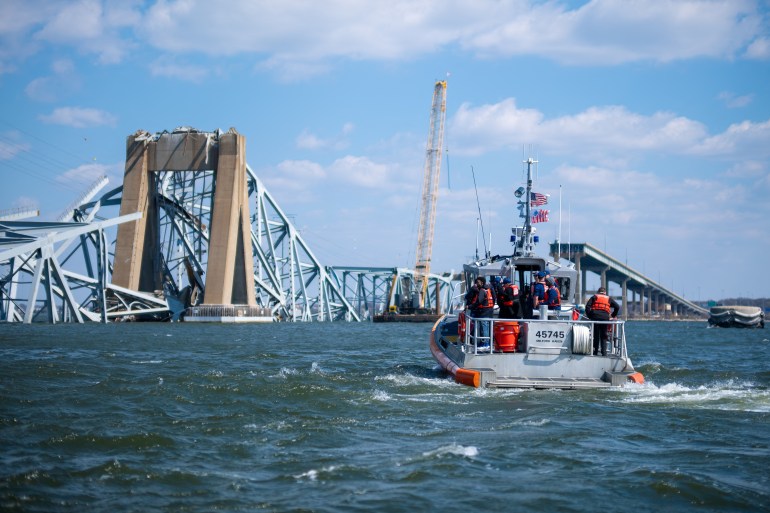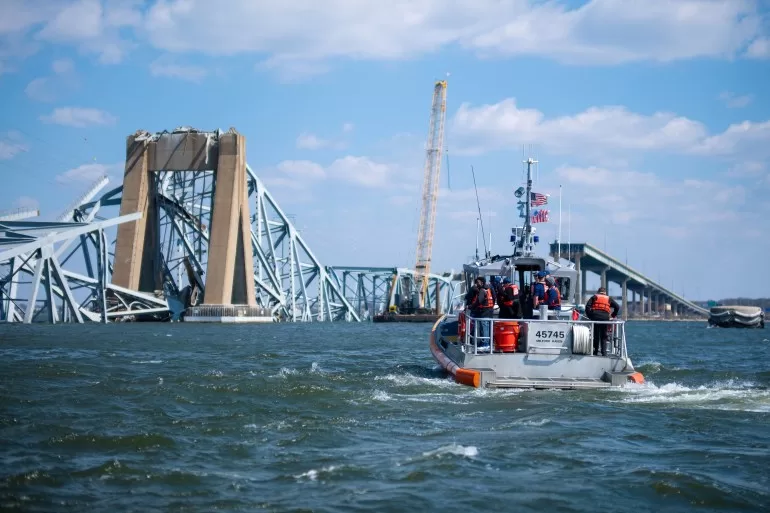On Wednesday, it was reported that Maryland would receive initial funding of $60m from the federal government as state authorities work to clear the debris from the disaster. This emergency relief funding is to cover “mobilisation, operations and debris recovery”, the state said.
Here’s what we know so far about how this suspension might affect trade, insurers and the supply chain.
What happened to the Baltimore bridge?
The Francis Scott Key Bridge in Baltimore, Maryland, a steel bridge opened in 1977 which spanned the lower Patapsco River and the outer Baltimore harbour, collapsed when a container ship hit one of its support pillars at about 1:27am (05:27 GMT) on Tuesday.
Cars that were crossing the bridge fell into the river, and six workers went missing and are now presumed dead.
The Singapore-registered ship which hit the bridge was named the Dali and was heading to Sri Lanka. All 22 crew members as well as two pilots have been accounted for and there were no reports of injuries.
Since the incident, vessel traffic has been suspended in and out of the port. However, the port is not closed and trucks are still being processed within the maritime terminals.

How important is the Baltimore port for trade?
The Port of Baltimore is the ninth largest US port in terms of overall trade volume. It handles cargo including automobiles, machinery, agricultural equipment, liquefied natural gas and sugar.
In 2023, the port handled about 50 million tonnes and $80bn of cargo moving between the US and other countries.
The port processed 847,158 automobiles last year, according to figures from the state of Maryland. About 70 percent of these were imported.
Nearly 20 percent of US coal exports pass through Baltimore.
More than 50 ocean shipping and cruise ship companies carry out business with the port, according to the state. Their vessels visit the port about 1,800 times per year.
What is the economic cost of the bridge collapse?
During a briefing at the bridge collapse scene, the US Representative for Maryland, David Trone, said that state and federal officials estimated the port’s closure would cost the economy as much as $15m per day.
Additionally, the port directly supports more than 15,000 jobs, with an additional 140,000 jobs dependent on port activity overall, according to Maryland Governor Wes Moore’s office.
This does not mean that these individuals will be laid off, but less traffic will mean they have less work to do. Being day labourers, they may lose wages.
Delays can also be expected by companies and customers as packages bound for processing at the port will have to be diverted elsewhere.
Losses stemming from the bridge collapse are likely to hit the insurance sector hard. Last week, Bloomberg reported that insurers could face claims amounting to as much as $3bn – including claims for damage to the bridge itself, liabilities for wrongful deaths and disruption to businesses caused by the closure of the port as ships bound for Baltimore will have to go elsewhere.
Bruce Carnegie-Brown, chairman of Lloyd’s insurance market in London, where many of the insurers facing claims for this incident are based, told Reuters that the collapse is likely to lead to a “multibillion-dollar insurance loss” and could become the “largest single marine insurance loss”.
The estimated time of arrival for Baltimore-bound vessels doubled between Monday and Tuesday, according to Windward, a maritime risk management company. Windward additionally predicted that ships scheduled to go to Baltimore would be delayed by at least 24 days.
However, experts say that the knock-on effects of the suspension should be manageable in the short term. After all, Baltimore’s port holds just 4 percent of all East Coast trade volume, according to S&P Global.
How will businesses using the port be affected?
Several companies which use the port have said the suspension will not negatively affect short-term operations. The US’s largest sugar company, ASR group, reported that it has six to eight weeks of raw sugar stocks at its Baltimore refinery, which is supplied by vessels coming to the port.
Berkshire Hathaway Energy, the operator of the Cove Point liquefied natural gas terminal, also said operations were not immediately affected. German car manufacturer BMW said that, besides short-term traffic delays, it does not expect other short-term impacts. Volkswagen, Mercedes and General Motors also expect little to no effect besides delays.
However, Ford Motor Company chief financial officer John Lawler told Reuters on Tuesday: “We’ll have to divert parts to other ports … It will probably lengthen the supply chain a bit.”
Where will Baltimore-bound ships and containers be diverted to?
Baltimore-bound ships are currently anchored beyond the port and waiting to be rerouted to other ports up and down the East Coast in the US.
Ports in Philadelphia, Wilmington, Delaware; Newark, New Jersey; Norfolk; Charleston, South Carolina; Jacksonville, Florida; and Georgia also could see additional cargo.
While the Georgia Ports Authority, which owns ports in Savannah and Brunswick, said it has the capacity to take on more cargo, it can not make up for Baltimore by itself.
Part of Baltimore’s operations are still operational, east of where the bridge collapsed, the port said. Hence, it can still handle automobiles from companies including BMW and Volkswagen.
How will consumers be affected?
Supply chain experts say US port infrastructure is stronger than it was in 2021 and 2022 when businesses were understaffed and struggling with backlogs of ships and containers as a result of the COVID-19 pandemic. This caused consumer prices to spike. Experts do not expect this to happen on a wide scale now.
“The collapse of the Francis Scott Key Bridge in Maryland is another reminder of the US vulnerability to supply-chain shocks, but this event will have greater economic implications for the Baltimore economy than nationally,” Ryan Sweet, chief US economist at Oxford Economics, wrote in a note.
“We don’t anticipate that the disruptions to trade or transportation will be visible in US GDP, and the implications for inflation are minimal,” he added.
Where else in the world has shipping been disrupted?
Attacks on the Red Sea by Yemen’s Houthi group have reduced traffic travelling through the Suez Canal, through which some 15 percent of the world’s shipping traffic passes. Diverted cargo shipments between Asia and Europe are causing price rises for manufacturers.
Additionally, the Panama Canal, which handles 6 percent of the world’s maritime commerce, is experiencing decreasing water levels, reducing the canal’s capacity and hence the number of ships able to pass through it. In late August 2023, drought conditions caused the Panama Canal to announce prolonged transit restrictions.
Compared with lingering supply-chain effects caused by the Red Sea attacks and COVID-19, experts say the fallout from the bridge collapse will be temporary.
